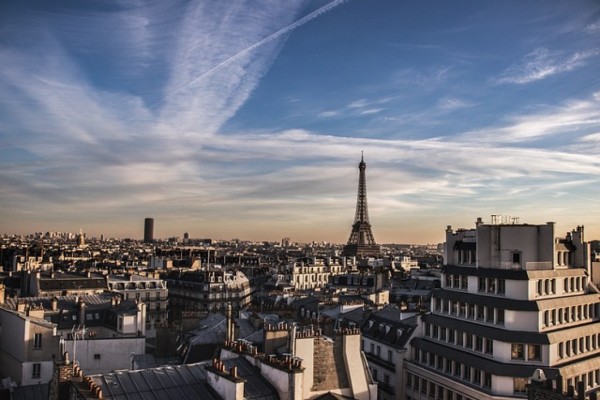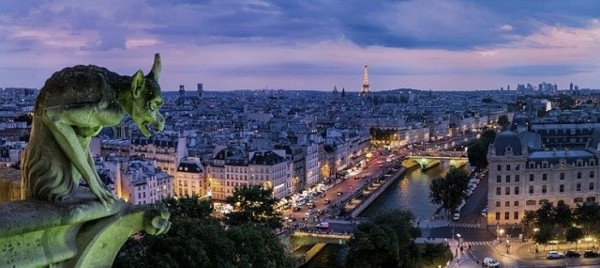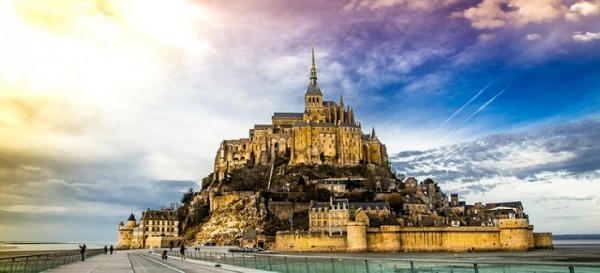Overview
France offers an amazing historic heritage and probably the most diversified natural environment of Europe. Its tourist attractions indulge the history of the human race, from the prehistoric sites of Cro Magnon to the steel and glass of the Futuroscope; they include fine vestiges of all European civilisations, from the prehistoric megaliths of Carnac and the Roman remains of Provence, through medieval castles and cathedrals, to the splendours of Versailles, the nineteenth century Eiffel Tower, or the resolute modernity of the TGV.
In addition, France has the necessary tourism infrastructure to cope with its status as leading tourist destination - more hotels and campsites, probably more gites or holiday cottages, the best and most modern rail network in Europe, and a fine system of motorways linking all main towns and cities.
This information has been compiled for your reference in good faith but please use this only as a general guide. We advise you to check with relevant authorities with regard to the latest requirement for passport, visa, travel advisory, entry restrictions, health requirements, local currency etc as these are subjected to change with without prior notice and our information given below may not be as updated.
Best time to go: The best time to visit France is in the spring (April to June) or fall (September to November) when there are fewer tourists, lower prices, and moderate temperatures. The summer months can be hot, crowded, and expensive. The winter months are often grey, wet, and cold (though a great time to visit the museums of Paris).
France is the largest country in the EU, and known as 'the hexagon' with an area of 551,000 sq km it's almost a fifth of the EU’s total area.
Visa: New Zealand citizens do not require a visa to enter the Schengen area. Under the Visa Waiver Program you can visit France without a visa and stay for up to 3 months. You must have a passport valid for a period of at least 3 months beyond the planned date of departure from the Schengen area.
The French Army was the first to use camouflage in 1915 (World War I)
Currency: Current valid currency in France is Euro (€), the French currency Bills/ notes are 500/ 200/ 100/ 50/ 20/ 10/ 5 Coins available; 2€/1€/50 cents/20c/10c/5c/2c/1c. One Euro is divided into 100 cents, or centimes.
Currency exchange can be made in most banks and post offices as well as in some large stores, train stations, airports and exchange offices near major tourist sites. Look for a sign indicating "Change". ATMs (known locally as distributeurs automatiques de billets) often have the best exchange rates. Think of withdrawing directly from your savings, not from your credit card, which treats the transaction as a cash advance.
U.S. dollars are not accepted in most establishments, though some hotels, shops, and restaurants may accept U.S. dollars at an agreed upon exchange rate.
France was the first country in the world to ban supermarkets from throwing away or destroying unsold food
Health: France does not have any particular health risk. Foreign visitors should check at home whether you need vaccinations or not, but the general rule is that you won't. All travellers should be up to date on routine vaccinations when travelling to France and keep your valid up to date travel insurance when required.
The French have produced a number of world-renown inventions
Food and drinks: French cuisine is surprisingly simple, but with somewhat complex cooking techniques. It is and always has been based on quality fresh ingredients. Dining, however was one of the first aspects of food that has changed; French Medieval cuisine was served (among the upper class) in the form of large banquets as the tables would be overwhelmed with food.
All popular drinks are available in France, including numerous non-alcoholic drinks. Coffee, tea, soft drinks, juices, and milk are all commonly available and accessible. However, France is best known for their wines and champagne. Every region and even sub-region or hillside in France has different soils and weather, catering to the growth of differing grapes.
About one million French people living near the border with Italy speak Italian
Clothing: Traditional regional costumes are still worn at festivals and celebrations. In Alsace, women may be seen in white, lace-trimmed blouses and aprons decorated with colorful flowers. Women's costumes in Normandy include white, flared bonnets and dresses with wide, elbow-length sleeves.
Both French men and women wear sophisticated, elegant clothing. As a result, many American tourists often feel underdressed compared to the French natives. One of the cardinal rules of the French dress code is wearing understated, well-fitting clothes. It follows that the sweatpants and oversized T-shirt look popular in North America is seldom seen among the French, unless they are in the privacy of their own home. More specifically, the French prefer a tidy look that does not reveal.
A French woman is the world’s oldest ever human
Language: The national language, French, is the only official language according to the second article of the French Constitution, and its standardized variant is by far the most widely spoken. Several regional languages are also spoken to varying degrees as a secondary language after French, such as German dialects, Celtic languages and other Gallo-Romance languages. Some of these languages have also been spoken in neighbouring countries, such as Belgium, Germany, Switzerland, Italy or Spain.
The Louvre Museum in Paris was the most visited museum in the world in 2014
Gratuities: Tipping in France Almost all restaurants include tax and a 15% service charge (service compris) in their prices. If a meal or service has been particularly good, leaving another 2-3% is customary, as is leaving the waiter the small change from your bill if you pay in cash. If service is not included (service non compris) a 15% tip is appropriate. In hotels, tip porters approximately 1.50€ for each bag and chambermaids 1.50€ a day. Taxi drivers would expect 10-15% tip of the metered fare. Small tips of around 1€ are reasonable for cloakroom and washroom attendants, ushers and museum tour guides. It is standard practice to tip tour guides and bus drivers after an excursion, generally 1.50-3.00€, depending on your level of the satisfaction.
The world’s first artificial heart transplant and face transplant both took place in France
Safety & security: Generally speaking, there is not much to worry about when it comes to safety and security in France. Always look for the media and travel alerts while visiting any country. However as a generic note you need to take care of your personal safety and looking after your belongings so that you can have a safe and enjoyable time while travelling.
Airport tax: Your international air ticket should include airport tax on international departure.
Totalling around 29,000km, the French rail network is the second largest in Europe and the ninth biggest in the world
Internet: Internet facilities are available at almost in many places. Most hotels have it and internet cafes are commonly found in all major cities and tourist places.
Telephone: France has a dialling code of +33 from New Zealand. While calling New Zealand from France, you will need to dial +64…Pre-paid calling cards are sold in many shops and airport. If you want to call internationally, ask for an international calling card.
The French invented the metric system, the decimalised way of counting and weighing
Time Difference: France is 10 hours behind New Zealand from April to September and 11 hours from October to March.
Photography: It is normally forbidden to take photographs of government buildings, airports and buildings of military importance. Many museums prohibit photography without a permit; some prohibit only flash or tripod photography.
Paris Gare du Nord is Europe's busiest railway station
Electricity: For France there are two associated plug types, types C and E. Plug type C is the plug which has two round pins and plug type E is the plug which has two round pins and a hole for the socket's male earthing pin. France operates on a 230V supply voltage and 50Hz. Few Hotels have adapters available which you could borrow free of charge during your stay but it might be a good idea to carry one from home. Please visit this website for more information on plugs: http://kropla.com/electric2.htm
Postage: La Poste is France’s official postal service.
France produces nearly a billion tons of cheese a year in around 1,200 different varieties
Cities of interest
Paris
France's capital, is a major European city and a global center for art, fashion, gastronomy and culture. Its 19th-century cityscape is crisscrossed by wide boulevards and the River Seine. Beyond such landmarks as the Eiffel Tower and the 12th-century, Gothic Notre-Dame cathedral, the city is known for its cafe culture and designer boutiques along the Rue du Faubourg Saint-Honoré.
The famed Louvre museum houses da Vinci’s “Mona Lisa.” The Musée d’Orsay has Impressionist works by Monet, Degas and Renoir. On the Seine’s Right Bank, the Montmartre neighborhood is home to Sacré-Coeur Basilica and sweeping hilltop views. In the Marais, nightclubs sit among restored 17th-century mansions. On the Left Bank are the Latin Quarter, bustling with Sorbonne scholars, and the historically bohemian Saint-Germain-des-Prés. The city’s open-air cafes are an institution for casual eating and people-watching. Fine-dining restaurants, bistros, markets and patisseries reflect other aspects of France's famed culinary heritage.
Nice
Capital of the Alpes-Maritimes department on the French Riviera, situated on the pebbly shores of the Baie des Anges. Founded by the Greeks and later a retreat for 19th-century European elite, the city has also long attracted artists.
The city's Modern and Contemporary Art Museum (or MAMAC) is an imposing modernist structure displaying avant garde works by French and international artists. Vieux Nice, a maze of medieval streets, features baroque churches and the colorful Cours Saleya market, famed for its flowers, fish and produce. The Promenade des Anglais, a boulevard fronting the bay, is lined with grand cafes and hotels such as the wedding-cake Le Negresco. The birthplace of salade niçoise, Nice is known for dishes made with olives and seafood, and for the street-food staple, socca (chickpea pancakes).
French Riviera
The French Riviera (or Côte d'Azur) is the Mediterranean coast of southeastern France. It includes famously glamorous beach resorts such as Saint-Tropez and Cannes, and the independent microstate of Monaco. A health retreat in the 18th century, the area later attracted aristocrats, artists and the 1960s "jet set." Today it’s an established holiday destination, with paths connecting many coastal villages and towns.
Saint-Tropez is known for its glitzy nightlife and picturesque old port. Neighboring Sainte-Maxime offers sailing and waterskiing. Luxury boutiques and hotels line Cannes’ seafront Promenade de la Croisette, the backdrop to its famous film festival.
Discover Paris, Provance and French Riviera
Experience the glitz and glamour of the French Riviera and South of France, the colourful landscapes, history and traditions. Admire the various landscapes of Burgundy and the Rhone Valley.10 DAYS
Explore Paris
Paris is a wonderful city that you can visit again and again and still discover something new each time you go, but you don’t necessarily need a lot of time to get something out of a trip to the City6 DAYS
Paris & Normandy Highlights
On this nine-day tour, you will discover Paris and Normandy.9 DAYS


